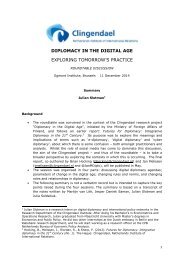BM_IMD_REPORT-How-Authentic-is-your-Corporate-Purpose
BM_IMD_REPORT-How-Authentic-is-your-Corporate-Purpose
BM_IMD_REPORT-How-Authentic-is-your-Corporate-Purpose
You also want an ePaper? Increase the reach of your titles
YUMPU automatically turns print PDFs into web optimized ePapers that Google loves.
Research by Burson-Marsteller and <strong>IMD</strong>’s Center for <strong>Corporate</strong> Sustainability in 2010 validated the<br />
importance that corporate purpose plays in firm performance. 1 In particular, the study found that:<br />
• A well-executed corporate purpose communication strategy enhances the financial<br />
performance of leading European companies;<br />
• A well-executed corporate purpose communication strategy <strong>is</strong> more important than<br />
company size in terms of its effect on financial performance;<br />
• <strong>Corporate</strong> purpose enhances not only economy-wide financial performance of leading<br />
European companies but also relative financial performance within industries. 2<br />
Unfortunately, corporate purpose can act as a double-edged sword. On the one hand, a corporate<br />
purpose that <strong>is</strong> cons<strong>is</strong>tent with related and relevant strategic corporate actions can build, sustain<br />
and increase trust. On the other hand, a corporate purpose that <strong>is</strong> incons<strong>is</strong>tent with corporate<br />
actions, will lead stakeholders to view the corporate purpose and the company with m<strong>is</strong>trust and<br />
skeptic<strong>is</strong>m. The research described in th<strong>is</strong> report revealed once again that companies absolutely<br />
need to “walk the talk” in order to be credible and authentic with regard to their corporate purpose<br />
statements. <strong>How</strong>ever, it also revealed that “talking the walk” was an equally important part of the<br />
paradigm. Since perception – built on awareness and knowledge gained through experience,<br />
learning and communication – <strong>is</strong> often reality, corporate purpose messages must be carefully tuned<br />
to indicators that demonstrate that the organization effectively “walks its talk.”<br />
For organizations to overcome th<strong>is</strong> double-edged sword and build trust with stakeholders, their<br />
corporate purposes must be aligned with their strategic dec<strong>is</strong>ions and actions in order to be<br />
perceived as “authentic.”<br />
Understanding how to manage the authenticity of their corporate purpose successfully <strong>is</strong> a challenge<br />
for many organizations’ leaders and managers. The goal of th<strong>is</strong> report <strong>is</strong> to put forth a model for<br />
authentic corporate purpose. Our hope <strong>is</strong> that th<strong>is</strong> model will help business leaders effectively<br />
manage their firm’s authenticity into the future.<br />
2. Methodology<br />
Similar to procedures followed in previous research on authenticity in different domains, we began<br />
with an item development and validation process that followed several steps. First, we compiled a<br />
l<strong>is</strong>t of possible authenticity dimensions based on an extensive literature review of empirical research<br />
conducted in other relevant domains, including psychology, philosophy, leadership, strategy and<br />
marketing.<br />
Next, we generated a pool of items from the literature based on these dimensions, identifying items<br />
that have empirically been shown to capture the different dimensions of authenticity in these<br />
various d<strong>is</strong>ciplines. Based on th<strong>is</strong> literature review, twelve initial dimensions and forty eight items<br />
were identified that related to the construct of authenticity of corporate purpose with scales<br />
adopted from the following research: continuity/cons<strong>is</strong>tency, originality, naturalness and reliability<br />
1 “ Communicating <strong>Corporate</strong> <strong>Purpose</strong>,” <strong>IMD</strong> and Burson-Marsteller, 2010 Link: http://bursonmarsteller.eu/wp-content/uploads/2011/10/<strong>IMD</strong>-B-M-<strong>Corporate</strong>-<strong>Purpose</strong>-Impact-Study-2010.pdf<br />
2 “ Communicating <strong>Corporate</strong> <strong>Purpose</strong>”, page 26<br />
9








